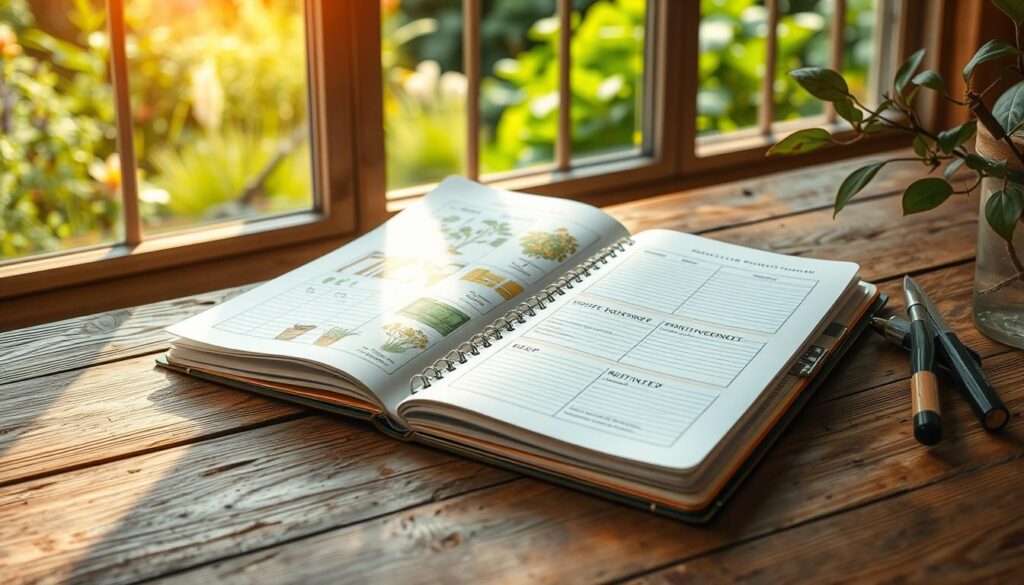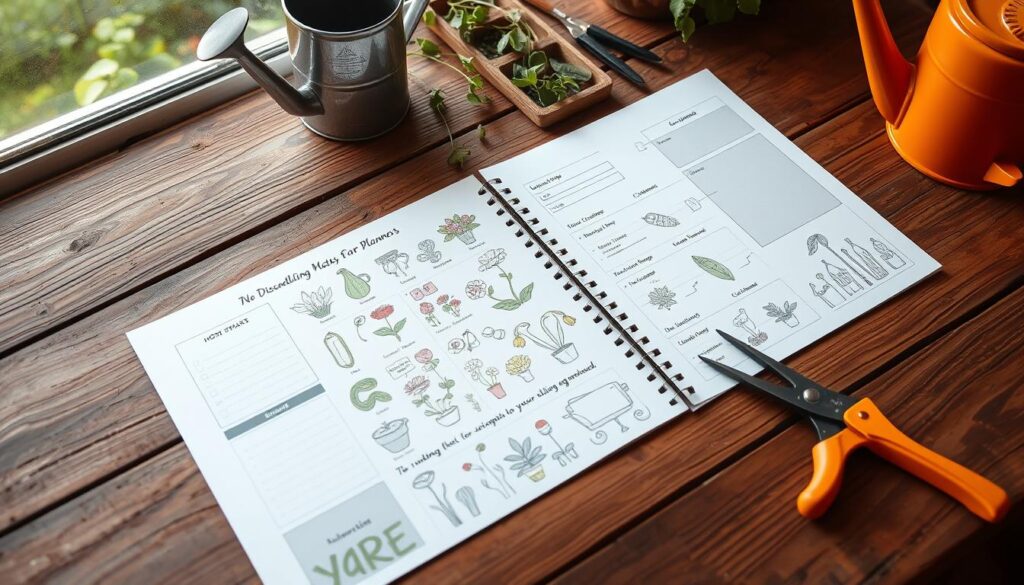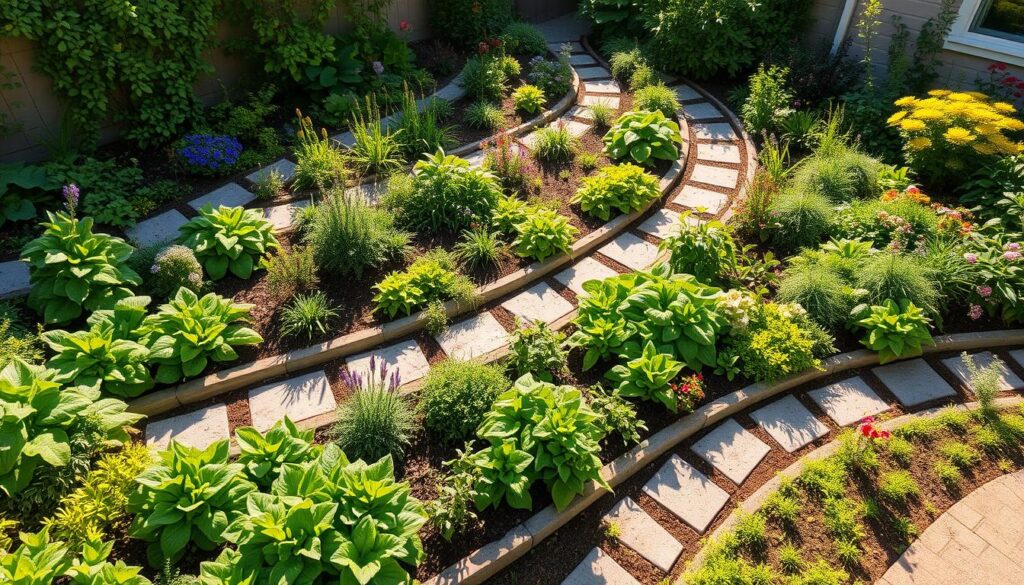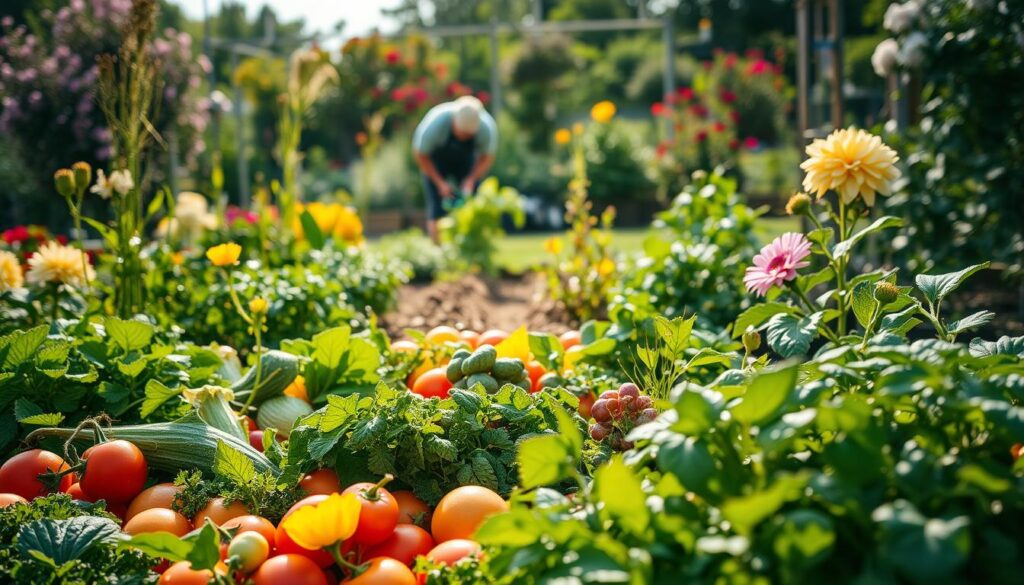Gardening is more than just planting seeds—it’s a creative and therapeutic journey. Whether you’re dreaming of a lush backyard or a cozy urban plot, planning your space can be as rewarding as watching your plants grow. A well-organized approach ensures every detail is accounted for, from soil types to seasonal blooms.
One tool that stands out is the 38-page reusable binder system. Designed for multi-year use, it adapts to your evolving needs. The printable cover and spine allow for personalization, letting you add your unique touch with washi tape or stickers. This makes it not just a planner, but a reflection of your creativity.
Take inspiration from Paint Water Farm, where their garden has transformed over the years. Whether you’re working with a small balcony or a sprawling homestead, this system is flexible enough to fit your vision. Plus, the artist-designed pages add an extra layer of inspiration to your planning process.
Key Takeaways
- Gardening planning is a therapeutic and creative activity.
- The 38-page binder system is reusable and customizable for multi-year use.
- Personalize your planner with printable covers and decorative elements.
- Adaptable for spaces of all sizes, from urban plots to large homesteads.
- Artist-designed pages add inspiration to your garden planning process.
Why You Need a Free Printable Garden Planner
Efficient planning is the key to maximizing your garden’s potential year after year. A structured approach ensures every detail is accounted for, from soil preparation to plant placement. This not only saves time but also boosts productivity, making your efforts more rewarding.

The Benefits of Organized Garden Planning
Structured layouts, like the 8×4 bed template, can increase yields by up to 23%. This grid system optimizes space and ensures each plant has enough room to thrive. For example, Brandywine tomatoes grown in a planned layout showed significant improvement in size and quality compared to haphazard planting.
Companion planting is another advantage. Pairing marigolds with vegetables naturally deters pests, reducing the need for chemicals. This method not only protects your plants but also promotes a healthier ecosystem.
How a Planner Can Maximize Your Yields
Tracking crop rotation over five years prevents soil depletion and reduces disease risks. This long-term strategy ensures your soil remains fertile and productive. Additionally, a cost analysis shows that homegrown produce averages $1.50 per pound, making it a budget-friendly alternative to store-bought options.
Annette’s salsa garden template is a great example of focused planning. By selecting specific pepper varieties, she ensures a consistent harvest tailored to her needs. This level of detail makes gardening both efficient and enjoyable.
Multi-generational use is another highlight. Kid-friendly drawing templates encourage younger family members to participate, fostering a love for gardening early on. This not only creates lasting memories but also ensures the planner’s continued use over the years.
| Garden Layout | Yield Increase | Key Benefits |
|---|---|---|
| 8×4 Bed Template | 23% | Optimized space, better plant health |
| Companion Planting | N/A | Natural pest control, healthier ecosystem |
| 5-Year Crop Rotation | N/A | Soil fertility, reduced disease risk |
Getting Started with Your Free Printable Garden Planner
Starting your gardening journey with the right tools can make all the difference. A well-organized system ensures you stay on track from planting to harvest. Whether you prefer a physical binder or a digital setup, choosing the right planner is the first step to success.

Choosing the Right Planner for Your Needs
When deciding between a binder and a digital system, consider your preferences. A binder offers a tactile experience and is reusable year after year. Digital systems, on the other hand, provide flexibility and easy updates. Paint Water Farm’s case study shows that both systems have their unique advantages.
| System | Pros | Cons |
|---|---|---|
| Binder | Reusable, customizable, tactile | Requires physical storage |
| Digital | Easy updates, portable, space-saving | Requires tech access |
Essential Pages to Include in Your Planner
Your planner should have key pages to keep everything organized. A soil amendment tracker helps monitor soil health, while an expense worksheet keeps your budget in check. A seed starting schedule aligned with USDA zones ensures timely planting.
Include a template for recording germination rates. Baker Creek seeds boast a 98% success rate, making this tool invaluable. A dibble depth chart ensures perfect bulb planting, and a section for nursery tags keeps plant info handy.
For durability, consider laminating your pages. This makes them weatherproof and reusable for years to come. With these essentials, your planner becomes a powerful tool for a thriving garden.
Planning Your Garden Layout
A well-thought-out layout can transform your space into a thriving oasis. Whether you’re working with a small plot or a larger area, careful design ensures every plant gets the care it needs. Start by mapping out your bed arrangements to maximize sunlight and airflow.

Designing Beds for Optimal Growth
Creating the perfect bed involves more than just placing plants in the ground. Use a color-coded plant key to organize your layout. This helps you visualize where each plant will thrive. For example, taller plants like tomatoes can be placed at the back to avoid shading smaller ones.
Consider using vertical supports like tomato cages to save space. Sun mapping techniques are also essential for areas with partial shade. By understanding how sunlight moves across your space, you can position plants for optimal growth.
Square Foot Gardening: A Space-Saving Solution
Square foot gardening is a game-changer for small spaces. This method divides your bed into a 16-square grid, allowing you to grow more in less area. One success story highlights 68 pounds of produce harvested from just 32 square feet!
Layering plants by root depth maximizes space and resources. For example, shallow-rooted lettuce can grow alongside deeper-rooted carrots. Pairing marigolds with vegetables also helps deter pests naturally, creating a healthier ecosystem.
For more tips on efficient layouts, check out New Gen Living. Their resources can help you refine your plan and achieve your growing goals.
Seasonal Gardening Tips for Year-Round Success
Seasonal gardening ensures your efforts yield results all year long. By aligning your tasks with the changing seasons, you can optimize growth and enjoy a continuous harvest. Whether it’s starting seeds in spring or preparing for winter, timing is key to a thriving garden.

Spring Planting: What to Start Early
Spring is the perfect time to kick off your gardening projects. Begin by using a zone-specific frost date calculator to determine the best planting schedule. This tool helps you avoid unexpected cold snaps that could harm young plants.
Follow the 6-8 week rule for starting seeds indoors. This gives your plants a head start before transplanting them outside. For example, tomatoes and peppers thrive when started early, ensuring a robust harvest later in the year.
Consider overwintering herbs like rosemary to extend their lifespan. These hardy plants can survive colder months with proper care, providing fresh flavors year-round.
Winter Planning: Preparing for the Next Season
Winter is the ideal time to plan for the upcoming year. Use this season to test seed viability and stratify seeds that require cold treatment. This process mimics natural conditions, improving germination rates.
Build a cold frame to extend your growing season. This simple structure protects plants from frost, allowing you to grow greens and herbs even in colder months. It’s a great way to maximize your garden’s potential.
Take advantage of the downtime to save seeds from heirloom tomatoes. Properly stored seeds can be used for future planting, ensuring a sustainable garden for years to come.
- Use zone-specific frost date calculators for accurate planting schedules.
- Start seeds indoors 6-8 weeks before the last frost.
- Overwinter herbs like rosemary for year-round freshness.
- Test seed viability and stratify seeds during winter.
- Construct a cold frame to protect plants from frost.
- Save seeds from heirloom tomatoes for future use.
Tracking and Recording Your Garden’s Progress
Tracking your garden’s progress is essential for achieving long-term success and continuous improvement. By documenting your efforts, you can identify what works and what needs adjustment. This process helps you refine your approach and maximize your harvest year after year.
![]()
Using a Garden Journal to Monitor Growth
A garden journal is one of the most valuable tools for tracking progress. Whether you choose daily or weekly entries, consistency is key. Daily journaling allows you to capture small details, while weekly summaries provide a broader overview.
Photo documentation is another effective method. Take pictures at regular intervals to create a visual timeline of your garden’s growth. This helps you spot trends and make informed decisions for future plans.
Yield tracking is equally important. Use a spreadsheet to record the weight and quantity of your harvest. This data helps you evaluate the success of different plants and techniques.
Keeping Track of Pests, Problems, and Solutions
Managing pests and other problems is a critical part of gardening. Create a worksheet to log issues as they arise. Include details like the type of pest, affected plants, and the solutions you’ve tried.
Organic solutions, such as garlic spray, are effective and eco-friendly. Here’s a simple recipe: blend 10 garlic cloves with water, strain, and spray on affected plants. This natural remedy helps deter pests without harming your garden.
Soil health is another factor to monitor. Regular soil tests provide insights into nutrient levels and pH balance. Use these results to adjust your soil amendments and ensure optimal growing conditions.
| Tracking Method | Purpose | Benefits |
|---|---|---|
| Garden Journal | Monitor growth and progress | Identifies trends, improves future plans |
| Photo Documentation | Visual timeline of growth | Helps spot patterns and issues |
| Yield Tracking | Record harvest data | Evaluates plant success and techniques |
| Pest/Problem Worksheet | Log and solve issues | Improves pest management strategies |
By consistently tracking these things, you can create a comprehensive record of your garden’s journey. This not only helps you achieve better results but also makes gardening a more rewarding experience.
Conclusion: Start Planning Your Dream Garden Today
Transform your outdoor space into a thriving haven with thoughtful planning. A well-organized approach ensures every detail is accounted for, from soil preparation to plant placement. With the right tools, you can maximize your efforts and enjoy a bountiful harvest year after year.
Sign up for our newsletter today and receive a bonus seedling tracker to kickstart your journey. Share your progress with the #GardenPlannerChallenge and inspire others to join the movement. Upgrade your binder with pressed flower dividers for a personal touch.
Involve the whole family in the process with multi-generational planning tips. Use printable gift tags to share seeds and spread the joy of gardening. Remember, seasonal rotation is key to maintaining a healthy and productive space.
Start now and watch your dream garden come to life!

